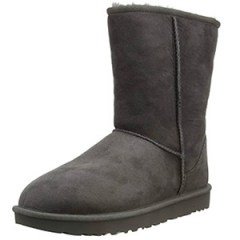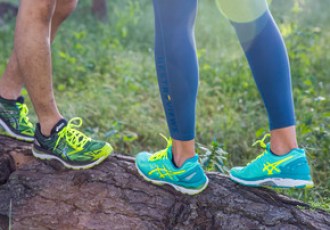
These popular boots will keep you both comfortable and warm while looking stylish.
These popular boots will keep you both comfortable and warm while looking stylish.
Made with waterproof leather and textile, lightweight midsole for extra comfort and high-level cushioning. Designed with Omni-Grip advanced traction rubber sole for slip-free movement. Lace-up closure provides adjustable fit. Available in multiple colors.
Some customers noted sizing is off.

This model is an affordable choice for boots that are comfortable, warm and cozy.
This model is an affordable choice for boots that are comfortable, warm and cozy.
100% suede round-toe boots with rubber sole, pinched seaming and fur lining. Designed with flexible non-marking outsole. Available in different colors.
A few costumes noted boots do not hold up for long.

These high-quality boots offer warmth, comfort, and practicality for the winter.
These high-quality boots offer warmth, comfort, and practicality for the winter.
100% waterproof boots with fleece lining for extra warmth, extended rubber exterior for extra protection, and comfortable insole for extra cushioning. EVA midsole provides even more support. Designed with technologies that provide dependable grip on snowy and icy surfaces.
Some customers noted boots not true-to-size.

These fashionable boots are both lightweight and durable.
These fashionable boots are both lightweight and durable.
Waterproof boots made with durable leather with synthetic overlays. Designed with rubber sole and lightweight midsole. Adjustable lace closure with D-ring eyelets and toggle make for a fastened fit.
Some customers noted sizes run small.

These warm, quality-designed boots are both cozy and tested to resist moisture and stains
These warm, quality-designed boots are both cozy and tested to resist moisture and stains
Made with sheepskin, rubber sole and overlock stitch on seams. Fully lined with fur and designed with ultra lightweight and ultra durable outsole compound. Available in multiple colors.
Some customers noted sizing is off.

We recommend these products based on an intensive research process that's designed to cut through the noise and find the top products in this space. Guided by experts, we spend hours looking into the factors that matter, to bring you these selections.

Just because Old Man Winter is doing his worst, that’s no reason for your feet to be cold. The right pair of snow boots will not only keep your feet toasty warm, but they will also keep your step secure on wet, icy, or snowy ground.
You don’t even have to sacrifice fashion for function. Many snow boots are stylish enough to match just about any outfit or personal taste.

While all snow boots are winter boots, not all winter boots are snow boots. Although there’s a lot of overlap between cold-weather boot designs, there are some differences, too.
Winter boots, as the name implies, are meant to be worn when the temperature takes a dive. These boots are warm and snug. Some have fleece or another thick lining for extra warmth. You’ll find winter boots made of leather, synthetics, or a blend of both. While it’s common for winter boots to be water resistant, and some are even waterproof, that’s not true for every winter boot, so check before purchasing if you live somewhere rainy.
When it comes to style, you’ll find winter boots that are very rugged, high fashion, and everything in between. You might even want to own several pairs so you can match your boot to your outfit and activity.
Rain boots also fall under the winter boot category. These boots are often simply rubber shells that tug on over your regular shoes to keep out water and keep your feet and footwear dry and protected.
Snow boots are very warm. Typically, these boots have a thick fleece or synthetic lining that keeps your tootsies warm and cozy even when the thermometer reads wells below freezing. Some snow boots are rated for temperature and comfort in the same way as sleeping bags. For example, boots might be rated for comfort down to -10°F or even -30°F. Not every manufacturer provides ratings, however, and even those that do suggest them as a guideline, not an absolute.
Usually, at a minimum, the soles, stitching, and uppers of snow boots are waterproof. The shaft of the boot might also be waterproof, or merely water resistant, so read labels before purchasing. Many snow boots, especially those made from nylon or other synthetic materials, have drawstrings or tabs around the top of the shaft so you can tighten the boot to keep out snow.
The tread of a snow boot is thick, rubbery, and usually deeply grooved to provide good traction on wet, slippery surfaces. The overall style of these cold-weather footwear staples is generally fairly rugged, although you can find some fashionable designs as well.
Removable liner: In some snow boots, particularly those made for hiking or other outdoor pursuits, the warm fleece or synthetic lining is removable. That means you can take out the liner, wash and dry it, and put it back into the boot – a big plus if you tend to have sweaty feet.
Drawstring closure: Stepping into a snowdrift and getting a boot full of snow is unpleasant, to say the least. A drawstring or snap closure at the top of the boot upper keeps snow where it belongs: out of your footwear.
Excellent traction: While all snow boots have rugged treads, some brands go further with soles engineered to offer the highest level of traction even when things get icy. Look for lugs, deep grooves, raised patterns, and extra “spikes” or points to keep you steady on your feet.
Laces: Most snow boots close with laces down the front of the upper. You’ll also find boots that close with clips, which is a great option if you have arthritis or weakness in your hands.
Padded tongue: A little bit of extra padding on the tongue of the boots makes them far more comfortable.
Waterproof: The best snow boots are entirely waterproof from top to bottom, not merely water resistant.
Temperature rating: If you plan on wearing your boots in the coldest climes or for extended outdoor activities, it’s worth seeking a manufacturer that rates its boots for temperature. You don’t want to buy a pair of snow boots only to discover too late that they aren’t warm enough for the conditions you face.
Outer material: Most snow boots are made of a rugged, synthetic polyester fabric such as Gore-Tex. Some boots have a rubber foot that attaches to a synthetic upper, while others are all leather or even suede. Although synthetics are easy to care for and tend to resist stains better than leather or suede, the choice of material mostly comes down to preference and style.
Lining material: Whether it’s real fleece, faux fleece, or a synthetic blend, the lining in your snow boots should be warm enough to keep your feet cozy but not so hot you feel like your feet are on fire.
Style: While a snow boot is a sturdy piece of footwear by definition, that doesn’t mean it has to lack all style. If you’ll be wearing your boots while running errands or commuting to work, you’ll probably prefer a tailored or elegant style, while snow boots purely for outdoor recreation can be as rugged as you please.
Fit: Once you find the style of snow boot you like best, it’s time to find the perfect fit. These tips will help you choose the right size.
Because your feet may swell as the day wears on, it’s best to shop for footwear– snow boots and other types as well – late in the afternoon. That way, you won’t wake up to snow boots that pinch.
It’s not true that you should buy snow boots a size larger than your regular shoes. Go for the same size you normally wear.
You should be able to wiggle your toes comfortably inside your boots. If you can’t, the toe box is too tight or the boots are too small.
Boots that fit correctly don’t slide up and down your heel as you walk or grind or press against it, either. The back of the boot should comfortably touch the back of your heel without rubbing, slipping, or squeezing.
While some snow boots take a bit of tugging to get on, it shouldn’t be a real struggle. If you feel like it’s a major workout just to put on your boots, they’re likely too small or the style isn’t right for your feet.
You shouldn’t feel any uncomfortable squeezing or pressure across the top of your foot.
The arches of your feet need good support. The right boots cradle your arches comfortably and take some of the pressure off your feet.
It should be fairly easy to fasten the boots. Whether they have laces or a system of straps and clips, you don’t want to spend too much time donning your footwear.
Inexpensive: If you’ll just be wearing the boots occasionally in conditions that aren’t too severe, you’ll find many satisfactory snow boots in the $30 to $50 range.
Mid-range: For $50 to $100, you’ll find nice boots that are well made, warm and snug, and reasonably fashionable.
High-end: If you live in an area with extremely cold winters, or you want boots to wear for outdoor sports, expect to pay $100 to $200 for the warmest boots with the best treads.

Q. How tall should my boots be?
A. While height is something of a personal preference, in general, your snow boots should come at least up to your lower calf to protect your feet and ankles from the cold and keep snow and slush out of your boots and your pants. If you’ll be in very cold conditions or participating in outdoor winter sports, you’ll be most comfortable in boots that come up higher on your calf.
Q. Do I wear my pants inside or outside my snow boots?
A. Ideally, you should tuck the bottoms of your pants into your snow boots and then fasten the boots’ drawstrings snugly around your leg. This prevents snow and slush from creeping into your shoes or up your pants.
Q. Are women’s snow boots really different from men’s boots?
A. While the styles might be very similar, women’s snow boots are sized and shaped appropriately to comfortably fit women’s feet, so you’ll be happiest with boots designed for women.
Get emails you’ll love.
Learn about the products you’re wondering if you should buy and get advice on using your latest purchases.
